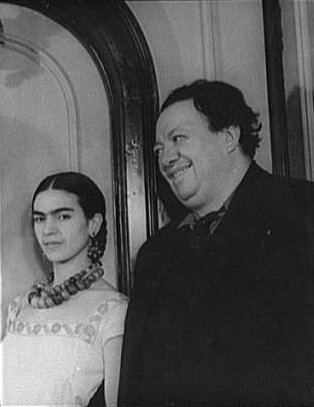Frida Kahlo
Frida Kahlo (July 6, 1907 – July 13, 1954) born Magdalena Carmen Frida Kahlo y Calderón was a Mexican painter, who  played an instrumental role in the Mexican and modern art scene. She painted using vibrant colours in a style that was influenced by indigenous cultures of Mexico as well as by European influences that include Realism, Symbolism, and Surrealism. Many of her works are self-portraits that symbolically express her own pain and sexuality.
played an instrumental role in the Mexican and modern art scene. She painted using vibrant colours in a style that was influenced by indigenous cultures of Mexico as well as by European influences that include Realism, Symbolism, and Surrealism. Many of her works are self-portraits that symbolically express her own pain and sexuality.
Early Life
The Mexican Revolution began in 1910 when Kahlo was three years old. Later, however, Kahlo claimed that she was born in 1910 so people would directly associate her with the revolution.
Kahlo contracted polio at age six, which left her right leg thinner than the left, which Kahlo disguised by wearing long skirts. In 1922, Kahlo was enrolled in the Preparatoria, one of Mexico’s premier schools. An important turning point in her life occurred on September 17, 1925, at age 18, when she was involved in a serious bus accident. She suffered serious injuries in the accident, including a broken spinal column, a broken collarbone, broken ribs, a broken pelvis, eleven fractures in her right leg, a crushed and dislocated right foot, and a dislocated shoulder. An iron handrail pierced her abdomen and her uterus, which seriously damaged her reproductive ability. Although she recovered from her injuries and eventually regained her ability to walk, she was plagued by relapses of extreme pain for the remainder of her life. The pain was intense and often left her confined to a hospital or bedridden for months at a time. She underwent as many as thirty-five operations as a result of the accident, mainly on her back, her right leg and her right foot.
Career as an Artist and Diego Rivera
The accident catalysed an important change in Kahlo’s life. Turning away from her studies, she began painting whilst convalescing. Kahlo approached the famous Mexican painter, Diego Rivera, to ask for guidance. They developed a strong bond, and eventually married in 1929.
Both Kahlo and Rivera had numerous extramarital affairs. The openly bisexual Kahlo had affairs with both men (including Leon Trotsky) and women; Rivera knew of and tolerated her relationships with women, but her relationships with men made him jealous. Rivera had an affair with her younger sister, Cristina, which led to the couple’s divorce. They remarried in 1940.
Communism and Death
Kaho and Rivera were both active communists, inviting Leon Trosky to stay with them whilst he sought political sanctuary.
Kahlo died in 1954 of a pulmonary embolism, She had been very ill throughout the previous year and her right leg had been amputated at the knee, owing to gangrene. Later, in his autobiography, Diego Rivera wrote that the day Kahlo died was the most tragic day of his life, adding that, too late, he had realized that the most wonderful part of his life had been his love for her. He ordered for their home, La Casa Azul, in Coyoacán, Mexico, to be converted into a museum after his death.
Style
Although she had one exhibition in New York in the 1930s, Kahlo was not recognised until the early 1980s with the onset of the artistic movement known as Neomexicanismo.
Kahlo painted in a deeply intimate and personal way, drawing on the personal tragedies she experienced, including miscarriages, physical pain and her marriage. Strongly influenced by Mexican culture, she used bright colors and dramatic symbolism. She frequently included the symbolic monkey. In Mexican mythology, monkeys are symbols of lust, but Kahlo portrayed them as tender and protective symbols. Christian and Jewish themes are often depicted in her work.
She also combined elements of the classic religious Mexican tradition with surrealist renderings. Kahlo created a few drawings of “portraits,” but unlike her paintings, they were more abstract. At the invitation of André Breton, she went to France in 1939 and was featured at an exhibition of her paintings in Paris. The Louvre bought one of her paintings, The Frame, which was displayed at the exhibit. This was the first work by a 20th century Mexican artist ever purchased by the internationally renowned museum.
In 2006, Kahlo’s 1943 painting Roots set a US$5.6 million auction record for a Latin American work.
References
- Herrera, Hayden (1983). A Biography of Frida Kahlo. New York: HarperCollins. p. 5. ISBN 978-0060085896.
See Also
External Links
- http://www.mexique-fr.com/frida.php
- Ronnen, Meir (2006-04-20). “Frida Kahlo’s father wasn’t Jewish after all”. The Jerusalem Post. http://www.jpost.com/servlet/Satellite?cid=1143498883340&pagename=JPArticle%2FShowFull. Retrieved 2009-09-02.


